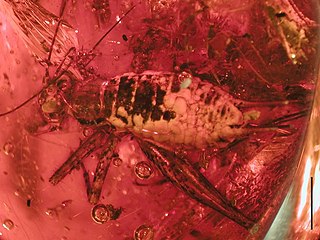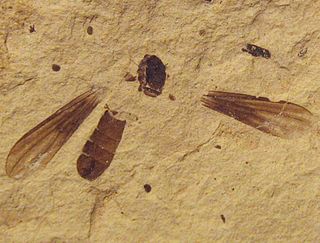
The Mymarommatidae, sometimes referred to as false fairy wasps, are a very small family of microscopic parasitic wasps. Only about half of the known species are living taxa, but they are found worldwide.

The Stephanidae, sometimes called crown wasps, are a family of parasitoid wasps. They are the only living members of the superfamily Stephanoidea. Stephanidae has at least 345 living species in 11 genera. The family is considered cosmopolitan in distribution, with the highest species concentrations in subtropical and moderate climate zones. Stephanidae also contain four extinct genera described from both compression fossils and inclusions in amber.

Baltic amber or succinite is amber from the Baltic region, home of its largest known deposits. It was produced sometime during the Eocene epoch, but exactly when is controversial. It has been estimated that this forested region provided the resin for more than 100,000 tons of amber. Today, more than 90% of the world's amber comes from Kaliningrad Oblast of Russia. It is a major source of income for the region; the local Kaliningrad Amber Combine extracted 250 tonnes of it in 2014 and 400 tonnes in 2015. Baltic amber is also found in Poland, as well as the Baltic states.
Electrinocellia is an extinct monotypic genus of snakefly in the family Inocelliidae containing the single species Electrinocellia peculiaris and known from Eocene aged Baltic amber.

Styporaphidia is a genus of snakefly, belonging to the extinct family Mesoraphidiidae, containing up to three species, the type species Styporaphidia magia, Styporaphidia willmanni and tentatively Styporaphidia? hispanica. The genus was named from the Greek stypos meaning "stem" or "stump" and Raphidia, the type genus for, and most often used as, a stem for generic names in the order Raphidioptera. The species name of S. magia is from the Greek word mageia meaning "magic" while the species name for S.? hispanica is from the Latin Hispania meaning "Spain" in reference to the type locality of the species.

Araneagryllus is an extinct monotypic genus of cricket in the subfamily Phalangopsinae with the sole species Araneagryllus dylani. The fossil was recovered in the Dominican Republic from early Miocene Burdigalian stage Dominican amber deposits on the island of Hispaniola. Araneagryllus is the first Phalangopsinae cricket to be described from the fossil record.

Aspidopleura is an extinct monotypic genus of parasitic wasp in the Eupelmidae subfamily Neanastatinae and at present, it contains the single species Aspidopleura baltica. The genus is solely known from the Early Eocene Baltic amber deposits in the Baltic Sea region of Europe.

Brevivulva is an extinct genus of parasitic wasp in the Eupelmidae subfamily Neanastatinae and contains the single species Brevivulva electroma. The genus is solely known from the Early Eocene Baltic amber deposits in the Baltic Sea region of Europe.

Neanaperiallus is an extinct monotypic genus of parasitic wasp in the Eupelmidae subfamily Neanastatinae containing only a single species, Neanaperiallus masneri. The genus is solely known from the Early Eocene Baltic amber deposits in the Baltic Sea region of Europe.
Glisachaemus is an extinct monotypic genus of planthopper in the Cixiidae subfamily Cixiinae and at present, it contains the single species Glisachaemus jonasdamzeni. The genus is solely known from the Early Eocene Baltic amber deposits in the Baltic Sea region of Europe.
Avitomyrmex is an extinct genus of bulldog ants in the subfamily Myrmeciinae which contains three described species. The genus was described in 2006 from Ypresian stage deposits of British Columbia, Canada. Almost all the specimens collected are queens, with an exception of a single fossilised worker. These ants are large, and the eyes are also large and well-developed; a sting is present in one species. The behaviour of these ants may have been similar to extant Myrmeciinae ants, such as foraging solitarily for arthropod prey and never leaving pheromone trails to food sources. Avitomyrmex has not been assigned to any tribe, instead generally being regarded as incertae sedis within Myrmeciinae. However, its identity as an ant has been challenged, although it is undoubtedly a hymenopteran insect.

Macabeemyrma is an extinct genus of bulldog ants in the subfamily Myrmeciinae containing the single species Macabeemyrma ovata, described in 2006 from Ypresian stage deposits of British Columbia, Canada. Only a single specimen is known; a holotype queen found preserved as a compression fossil. The specimen had no wings and small portions of its legs and eyes were faintly preserved. It was a large ant, reaching 25 millimetres (0.98 in) in length. This ants' behaviour would have been similar to that of extant Myrmeciinae ants, such as foraging singly in search for arthropod prey and nesting in soil or in trees. Macabeemyrma shows similarities to extinct ants in the genus Ypresiomyrma, and to the living Nothomyrmecia macrops, but has not been conclusively assigned to any tribe, instead generally regarded as incertae sedis within Myrmeciinae. However, the sole specimen lacks definitive traits, and its classification in Myrmeciinae, and even its identity as an ant, has been challenged.

Diochus electrus is an extinct species of rove beetle in genus Diochus, the only definitive fossil species in subfamily Staphylininae. The species is known only from the middle Eocene, Lutetian stage Baltic amber found in the Blaue Erde deposits, Baltic region, Northern Europe.

Alavaraphidia is an extinct genus of snakefly in the family Mesoraphidiidae. The genus is solely known from an Early Cretaceous, Albian age, fossil amber found in Spain. Currently, the genus comprises a single species, Alavaraphidia imperterrita.

Arostropsis is an extinct genus of broad-nosed weevil in the beetle family Curculionidae known from an Upper Eocene fossil found in Europe. The genus contains a single described species, Arostropsis groehni.
Protostephanus is an extinct genus of crown wasp in the Hymenoptera family Stephanidae known from an Eocene fossil found in the United States of America. The genus contains a single described species, Protostephanus ashmeadi placed in the stephanid subfamily Stephaninae.

Brownimecia is an extinct genus of ants, the only genus in the tribe Brownimeciini and subfamily Brownimeciinae of the Formicidae. Fossils of the identified species, Brownimecia clavata and Brownimecia inconspicua, are known from the Late Cretaceous of North America. The genus is one of several ants described from Late Cretaceous ambers of New Jersey. Brownimecia was initially placed in the subfamily Ponerinae, until it was transferred to its own subfamily in 2003; it can be distinguished from other ants due to its unusual sickle-like mandibles and other morphological features that makes this ant unique among the Formicidae. B. clavata is also small, measuring 3.43 millimetres (0.135 in), and a stinger is present in almost all of the specimens collected. The morphology of the mandibles suggest a high level of feeding specialization.

Haidomyrmex is an extinct genus of ants in the formicid subfamily Haidomyrmecinae, and is one of nine genera placed in the subfamily Haidomyrmecinae. The genus contains three described species Haidomyrmex cerberus, Haidomyrmex scimitarus, and Haidomyrmex zigrasi. All three are known from single Late Cretaceous fossils which have been found in Asia. H. cerberus is the type species and Haidomyrmex the type genus for the subfamily Haidomyrmecinae.

Metanephrocerus is an extinct genus of big-headed flies in the dipteran subfamily Protonephrocerinae, for which it is one of only two genera. The genus contains four described species, Metanephrocerus belgardeae, M. collini, M. groehni, and M. hoffeinsorum. Metanephrocerus is known from a group of Middle Eocene fossils which were found in Europe and a single early Eocene fossil from North America.
The Prussian Formation, previously known as the Amber Formation, is a geologic formation in Prussia, today mostly Kaliningrad Oblast that dates to the Eocene. It holds 90% of the world's amber supply and Baltic amber is found exclusively in the Prussian Formation.















